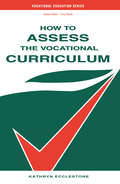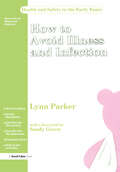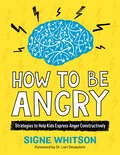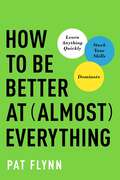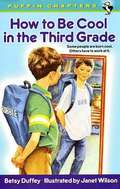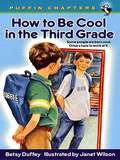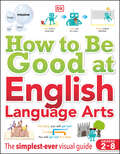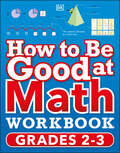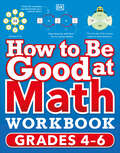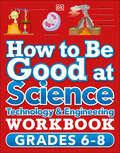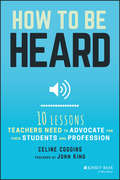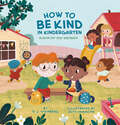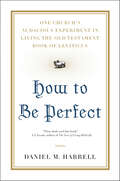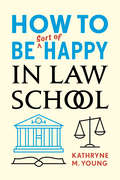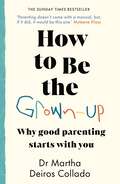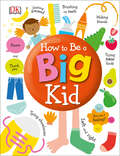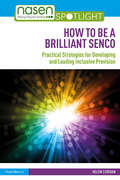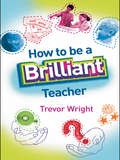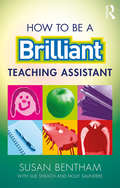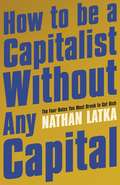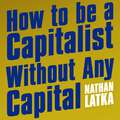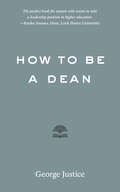- Table View
- List View
How to Assess the Vocational Curriculum (Vocational Education Ser.)
by Ecclestone, KathrynUsing case studies from schools and colleges, this book outlines different forms of assessment, highlights their purposes, and provides practical guidelines to their implementation.
How to Avoid Illness and Infection
by Lynn ParkerIf you work in Early Years settings it is essential that you are well informed and aware of health and safety issues and procedures that you may face on a day-to-day basis. This book will provide clear, concise and practical information about health and safety, whilst fully translating the legislative documentation that surrounds it to ensure that you meet OFSTED requirements, and that you are fulfilling your obligation in keeping the children under your care safe. Practical advice is offered on issues such as: common childhood infections and the exclusion periods relating to them routine medications records, policies and permissions protective clothing vaccination. Written in accordance with national health and safety standards that have to be achieved at inspection, this is part of a practical series of 'how to' guides that are essential purchases for anyone working in an Early Years setting looking to certify that their nursery environment safe as well as fun.
How to Be Angry: Strategies to Help Kids Express Anger Constructively
by Signe WhitsonChildren and teenagers often struggle to cope with anger, and angry feelings can boil over into aggression and destructive behaviour. This updated and extended resource takes a different approach to anger, teaching children how to be angry effectively, rather than telling them not to be angry at all.Encouraging appropriate anger management through group work and tailored lessons, the book is also accompanied by downloadable additional resources demonstrating the activities and offering adaptations for parents. Suitable for use with children and teenagers aged 5 - 18, this engaging resource will help children to overcome self-destructive patterns of passive, aggressive, and passive aggressive behaviour.
How to Be Better at Almost Everything: Learn Anything Quickly, Stack Your Skills, Dominate
by Pat FlynnMastering one specific skill set might have been the key to success 20 years ago . . . but being the best at a single thing just doesn't cut it in today's global economy. Think about those people who somehow manage to be amazing at everything they do—the multimillionaire CEO with the bodybuilder physique or the rock star with legions of adoring fans. How do they manage to be so great at life? By acquiring and applying multiple skills to make themselves more valuable to others, they've become generalists, able to "stack" their varied skills for a unique competitive edge. In How to Be Better at Almost Everything, bestselling author, fitness expert, entrepreneur, and professional business coach Pat Flynn shares the secrets to learning (almost) every skill, from marketing and music to relationships and martial arts, teaching how to combine interests to achieve greatness in any field. Discover how to: Learn any skill with only an hour of practice a day through repetition and resistance Package all your passions into a single tool kit for success with skill stacking Turn those passions into paychecks by transforming yourself into a person of interest To really get ahead in today's fast-paced, constantly evolving world, you need a diverse portfolio of hidden talents you can pull from your back pocket at a moment's notice. The good news? You don't need to be a genius or a prodigy to get there—you just have to be willing to learn. How to Be Better at Almost Everything will teach you how to make your personal and professional goals a reality, starting today.
How to Be Cool in the Third Grade
by Betsy DuffeyWhen Robbie York is marked as a target by a bully at school, he decides that the only way to survive the third grade is by being cool.
How to Be Cool in the Third Grade
by Betsy DuffeyIt's not easy to seem cool when the whole class knows you wear superhero underwear and your mom still kisses you goodbye at the bus stop. But Robbie York has a plan. 1) Get rid of the name Robbie. 2) Get jeans. 3)Avoid bullies like Bo Haney. If only it were that simple!
How to Be Good at English Language Arts: The Simplest-ever Visual Guide (DK How to Be Good at)
by DKIdeal for home learning, this simple and inspirational book has everything you need to get to grips with grammar and punctuation, and master essential reading and writing skills.Need help telling your adjectives from your adverbs? Struggling to work out what that poem is really about, or where to begin with your essay? Then this may be the book for you! How to be Good at English Language Arts uses short, straightforward explanations and clear graphics to shed light on the trickiest of topics, making this language-learning book the perfect guide to understanding and using the English language.Illustrated examples make daunting grammar accessible and fun, and help develop an understanding that can be applied to school studies. Annotated texts complement concise, practical guidance to support students in developing sound analytical and writing skills. The carefully selected reading recommendations will inspire reading for pleasure, while clear links between topics will ensure that students not only understand language techniques but know how to apply them effectively.Dive into the pages of this great grammar guide for kids to discover: -Visual explanations make concepts easy to grasp at first glance-Every topic is broken down into short sections of text written in simple language-Annotated texts provide students with clear guidance on identifying and applying language techniques effectively-&“Further reading&” features encourage reading for pleasure-&“World of words&” features bring English to life, connecting language on the page with language in the real world How to be Good at English Language Arts will inspire students to uncover and enjoy the art and power of language, supporting them on their way to becoming confident and accomplished readers, writers, and speakers. The highly visual approach alongside clear, short explanations breaks down the language and makes the subject easy to understand, whilst also supporting education curricula around the world for children aged 9-12; it is also suitable for foreign students studying English language and literature, and an ideal resource for children studying at home.
How to Be Good at Math Workbook Grades 2-3 (DK How to Be Good at)
by DKUnleash your child&’s inner math genius and help them master math for Grades 2 and 3!Whether you enjoy math or not, it&’s an essential subject to understand. See how everything adds up with this fully illustrated home-study guide.Get inspired by numbers and see how mathematical explanations come to life with this engaging math book for kids! It includes: • Full color, with a clear layout. • Clear instructions that are easy for children to follow by themselves. • Answers that are given at the back of the book. • Practice questions and practical exercises to help expand your child&’s knowledge of the subject. Make math manageableHow to be Good at Math Grade 2-3 keeps the math simple and easy to understand! It comes packed with eye-catching illustrations and easy-to-follow instructions to teach kids everything they need to know about math. This brilliant visual math workbook is ideal for reinforcing classroom teaching. It helps kids understand what they&’ve learned in school and gives them extra math revision practice before an important test!Perfect for kids ages 7-9, this colorful math practice book covers all the key areas of the school curriculum for this level. It includes fractions, multiplication, divisio, measurement, geometry, coordinates, data handling and graphs. And there are answers at the back to check that you're on the right path.This engaging and clear workbook accompanies How to be Good at Math Grade 4-6, which covers ages 9-11 (Grades 4, 5, and 6).Discover How to be Good in other subjectsDK&’s successful How to be Good at... workbook series provides your child with the tools to learn how to look at the world around them and figure out how it works. There are more books to discover! Learn all about the influence of science and technology in the modern age with How to Be Good at Science, Technology, and Engineering.
How to Be Good at Math Workbook, Grades 4-6: The simplest–ever visual workbook (DK How to Be Good at)
by DKHelp your child learn and master grade 4, 5 and 6 math in no timeWhether you&’re good at math or not, it&’s an essential subject to understand. Luckily, you don&’t have to be a math genius to follow along with this fully illustrated home-study guide!Get inspired by numbers and see how mathematical explanations come to life with this engaging math book for kids! It includes: • Full color pages, with clear, and easy to comprehend layouts • Clear instructions that are easy for children to follow by themselves. • Answer guides at the back of the book • Practice questions and practical exercises to help expand your child&’s knowledge of the subject. Make math manageablePacked with eye-catching illustrations and easy-to-follow instructions, How to be Good at Math Grade 4-6 continues to keep the math simple and easy to understand for kids! This brilliant visual math workbook teaches them everything they need to know about math. Ideal for reinforcing classroom teaching, it helps kids understand what they&’ve learned in school and gives them extra math revision practice before an important test!Perfect for children ages 9-11, this colorful math practice book covers all the key areas of the school curriculum for this level. It includes working with fractions and decimal numbers, percentages, long multiplication and division, measurement, geometry, coordinates, statistics, probability and basic algebra. And there are answers at the back to check that you&’re on the right path.This engaging and clear workbook accompanies How to be Good at Math Grade 2-3, which covers ages 7-9 (Grades 2 and 3).Help your child get better in other topicsDK&’s successful How to be Good at... workbook series provides your child with the tools to learn how to look at the world around them and figure out how it works. There are more books to discover! Learn all about the influence of science and technology in the modern age with How to Be Good at Science, Technology, and Engineering.
How to Be Good at Science, Technology and Engineering Workbook, Grade 6-8 (DK How to Be Good at)
by DKGain a complete understanding of Grades 6, 7 and 8 STEM subjects.From atoms and rocketships to vaccines and the human nervous system, this fully illustrated home learning workbook will help your child be at the top of their science class!This engaging science book for kids makes tricky topics and challenging concepts completely crystal clear! Here&’s what&’s inside: • Covers the core STEM topics, from biology, chemistry and physics, to technology. • Clearly laid out with easy-to-follow instructions for children to use by themselves. • Answers are given at the back of the book. • Practice questions and practical exercises to help expand your child&’s knowledge of the subject. Take your child&’s STEM learning to the next levelDid you know that many plants have a transport system to carry water and nutrients wherever they are needed? Or that most power stations around the world burn fossil fuels to make electricity? Packed with fascinating facts, fun graphics and step-by-step explanations, this brilliant visual workbook makes understanding science, technology and engineering super simple! It&’s perfect for extra science revision practice before an important test. Perfect for children ages 11-14, this colorful science practice book covers all the key areas of the school curriculum for this level. It includes genes and DNA, molecules, chemical reactions, the periodic table, heat transfer, electricity and magnetism, seasons and climate zones, and lots more. And there are answers at the back to check that you're on the right path.This engaging and clear science workbook accompanies How to be Good at Science, Technology, and Engineering Grade 2-5 which covers ages 7-11 (Grades 2, 3, 4 and 5).Discover How to be Good at other subjectsDK&’s successful How to be Good at... workbook series provides your child with the tools to learn how to look at the world around them and figure out how it works. There are more books to discover! Learn everything they need to know about math through eye-catching illustrations and easy-to-follow instructions with How to Be Good at Math.
How to Be Good at Science, Technology and Engineering Workbook, Grades 2-5 (DK How to Be Good at)
by DKHelp your child master Grade 2 to 5 STEM subjects and become a science superstar!From learning how the heart works to understanding what evolution is, this fully illustrated home learning workbook makes grasping science, technology and engineering as easy as ABC.This engaging science book for kids makes tricky topics and challenging concepts completely crystal clear! Here&’s what&’s inside: • Covers the core STEM topics for grades 2-5, from biology, chemistry and physics to technology. • Clearly laid out with easy-to-follow instructions for children to use by themselves. • Answers are given at the back of the book. • Practice questions and practical exercises to help expand your child&’s knowledge of the subject. Inspire your child with scienceDid you know that the human skeleton is made up of 206 bones? Or that the Earth&’s human population has quadrupled in the last hundred years? Packed with fascinating facts, fun graphics and step-by-step explanations, this brilliant visual workbook will keep budding scientists and engineers engaged. It helps kids understand what they&’ve learned in school and gives them extra science revision practice before an important test. Perfect for children ages 7-11, this colorful science practice book covers all the key areas of the school curriculum for this level. It includes the human body, animal and plant life, evolution, states of matter, energy, simple mechanics, the Earth, Moon and Sun, and lots more. And there are answers at the back to check that you&’re on the right path.This engaging and clear science workbook accompanies How to be Good at Science, Technology, and Engineering Grade 5-8 which covers ages 11-14 (Grades 5, 6, 7 and 8).Discover How to be Good in other subjectsDK&’s successful How to be Good at... workbook series provides your child with the tools to learn how to look at the world around them and figure out how it works. There are more books to discover! Learn everything they need to know about math through eye-catching illustrations and easy-to-follow instructions with How to Be Good at Math.
How to Be Heard: Ten Lessons Teachers Need to Advocate for their Students and Profession
by Celine CogginsTHE BOOK FOR EVERY TEACHER WHO HAS EVER BEEN FRUSTRATED BY THE DECISIONS MADE OUTSIDE THEIR SCHOOL THAT AFFECT THE STUDENTS INSIDE THEIR SCHOOL. How to Be Heard offers every teacher 10 ways to successfully amplify his or her voice, and demonstrates that when teachers' voices are heard, they will be rightfully recognized and supported as change leaders in their schools. Celine Coggins, a renowned teacher advocate, offers nuts-and-bolts strategies that are recognized as the "price of admission" to becoming a credible and welcomed participant in important policy conversations and decisions. The author clearly demonstrates that it is not only possible for teachers to initiate change, but to also effectively participate on the policy playing field. In ten clear chapters, the author demonstrates how teachers can and must advocate for their students and their profession. Throughout this book Coggins proves that "If you're not at the table, you're on the menu." This how-to guide is filled with concrete ideas for engaging in productive decision-making, using real-world examples from teachers who have successfully used these strategies.
How to Be Kind in Kindergarten: A Book for Your Backpack
by D.J. SteinbergFrom the best-selling author of the hugely popular Kindergarten, Here I Come!, here's a guidebook in verse that shows children how to be kind in the new and exciting world of kindergarten.Small enough to fit in a child's backpack, this collection of short poems--one to a page--spans the entire year of kindergarten, offering sweet and simple tips on how to be your best self--sharing your umbrella with a friend; taking turns on the swings, and inviting someone to join in a game. This is the perfect companion to DJ Steinberg's enormously successful Kindergarten, Here I Come!
How to Be Perfect: One Church's Audacious Experiment In Living the Old Testament Book of Leviticus
by Daniel M. HarrellInfluenced by A. J. Jacobs's The Year of Living Biblically, Harrell managed to recruit 20 members of his Boston congregation to join him in a month-long effort at living Levitically. Holiness was the ultimate goal, but so was learning.People who take the Bible seriously never know what to do with the book of Leviticus. And yet Leviticus is historically considered by Jews, and thus by Jesus, as the pivotal book of the Hebrew Bible. It's impossible to fully comprehend such key New Testament terms as sacrifice, atonement, or blood without some understanding of Leviticus. The "second greatest commandment," which Jesus said was "Love your neighbor as yourself," comes from Leviticus (19:18).As a longtime minister and preacher who had successfully skirted Leviticus for most of his life, author Daniel Harrell wanted to come to grips with all that Leviticus teaches -- not just loving neighbors, but the parts about animal sacrifice, Sabbath-keeping, skin diseases, homosexuality, and stoning sinners, too. Yet rather than approaching Leviticus with a view toward mitigating its commands, he decided to simply obey them. The surprising lessons they learned impressed on Harrell both the power of obedience and the necessity of grace. This book traces the adventures of a group of people eager to understand the Bible by living it.
How to Be Popular
by Meg CabotSixteen-year-old Steph Landry finds an old book on how to be popular and decides to change her social status by following its advice, much to the bafflement of her two best friends.
How to Be Sort of Happy in Law School
by Kathryne M. YoungEach year, over 40,000 new students enter America's law schools. Each new crop experiences startlingly high rates of depression, anxiety, fatigue, and dissatisfaction. Kathryne M. Young was one of those disgruntled law students. After finishing law school (and a PhD), she set out to learn more about the law school experience and how to improve it for future students. Young conducted one of the most ambitious studies of law students ever undertaken, charting the experiences of over 1000 law students from over 100 different law schools, along with hundreds of alumni, dropouts, law professors, and more. How to Be Sort of Happy in Law School is smart, compelling, and highly readable. Combining her own observations and experiences with the results of her study and the latest sociological research on law schools, Young offers a very different take from previous books about law school survival. Instead of assuming her readers should all aspire to law-review-and-big-firm notions of success, Young teaches students how to approach law school on their own terms: how to tune out the drumbeat of oppressive expectations and conventional wisdom to create a new breed of law school experience altogether. Young provides readers with practical tools for finding focus, happiness, and a sense of purpose while facing the seemingly endless onslaught of problems law school presents daily. This book is an indispensable companion for today's law students, prospective law students, and anyone who cares about making law students' lives better. Bursting with warmth, realism, and a touch of firebrand wit, How to Be Sort of Happy in Law School equips law students with much-needed wisdom for thriving during those three crucial years.
How to Be The Grown-Up: Why Good Parenting Starts with You
by Dr Martha Deiros ColladoINSTANT SUNDAY TIMES BESTSELLER‘Parenting doesn’t come with a manual, but if it did, it would be this one.’ Myleene Klass‘Brilliant … Dr Martha has guidance for almost every sticky moment.’ i PaperDrawing on her years of experience as a clinical psychologist, Dr Martha understands the questions all parents face: How can I make my child listen to me?How can I stop a tantrum in its tracks?What can I do when my child feels sad?Why is my child a picky eater and what can I do about it?What should I do when I lose my temper?With humour, boundless energy, wit and warmth, Dr Martha tackles it all; from how to talk about honesty and lies, death, co-parenting, consent, gender, attachment, boundaries, and tantrums, as well as the small but critical daily challenges parents face. She explains why beneath each dilemma, it's the behaviours and scripts we learned as children that shape the parents we become.This deceptively simple and always empathetic guide is a must-have toolkit for parents or any grown-up interested in what makes a healthy, happy, confident parent and child.‘Martha is my go-to expert for parenting. This book is full of real-life examples, lived experiences, useful strategies and so much reassurance.’ Charlotte Stirling-Reed, bestselling author of How to Wean Your Baby
How to Be a Big Kid
by DKThis super-handy book is a survival guide for the busiest job there is: being a preschoolerBeing little is hard work. There's so much for children to learn: tying their shoelaces, finding the right hole for each arm in a sweater, remembering to say "please" and "thank you," sharing toys with other children, and a whole bunch of other things, too. Then they're expected to go to school and learn even more. How to be a Big Kid is here to help children learn the skills they need to take care of themselves, get along with others, and be ready to go on their first day of school.
How to Be a Brilliant SENCO: Practical strategies for developing and leading inclusive provision (nasen spotlight)
by Helen CurranHelen Curran’s invaluable book aims to support new and experienced SENCOs with the task of developing and leading special educational needs provision and inclusive practice, through the exploration of practical strategies and approaches. This book takes a pragmatic approach to the issues which have historically been associated with the role of the SENCO; namely a lack of time, a lack of resources and often a lack of seniority. The book seeks to provide SENCOs with tried and tested ideas and strategies to support both the operational and strategic aspects of the role, to help SENCOs develop their role as a leader in school. The book covers the following areas: The SENCO role in policy and practice The SENCO as a leader Developing relationships with pupils and parents Challenges and opportunities within the role of SENCO A must read for any SENCO, this book draws upon case studies and real life examples, considering the ways in which SENCOs can shape and develop the status of not only their role, but also SEN and inclusive provision in their setting.
How to Be a Brilliant Teacher
by Trevor WrightThis cheerful and accessible book is packed with direct and practical advice drawn from the author’s extensive and successful personal experience as teacher-trainer, teacher and examiner. It sets out clear and practical guidelines to support and enhance your teaching skills. How to Be a Brilliant Teacher is aimed at teachers who want to develop their careers, or just be better teachers, by monitoring their own improvement. In order to do this, they may need to re-connect with theory, to consider their own practice explicitly, and to begin to see themselves as researchers. This book suggests how to get started. It is anecdotal and readable, and may be dipped into for innovative lesson ideas or read from cover-to-cover as a short, enjoyable course which discovers exciting principles in successful, practical experience. Although a practical book, at its heart lie essential values about good teaching and learning. In particular it will seek to re-introduce teacher initiative and creativity and to reconcile these with the growing number of preformed strategies that the teacher has to work with. In exploring the issues faced by teachers it addresses many common anxieties and offers focussed solutions to them. Chapters cover: creative planning managing learning, managing classrooms issues in literacy the paradox of inspirational teaching differentiation career planning and development. If How to be a Brilliant Trainee Teacher helped you during your training, this book will continue to provide valuable support to you as you move forward in the profession.
How to Be a Brilliant Teaching Assistant
by Susan BenthamHow to Be a Brilliant Teaching Assistant draws on knowledge from very experienced teaching assistants and Susan Bentham’s own extensive research to explore the common denominators that unite all brilliant teaching assistants. The book explores becoming a brilliant teaching assistant as a journey and not an end point, and provides support that will help you along the way, whether you’re just starting out in your career or you’ve been an experienced teaching assistant for years. This accessible book covers all aspects of the teaching assistant role, such as: Key roles and responsibilities Meta-cognition and understanding children’s learning Delivering high quality lessons alongside teachers Developing useful subject knowledge Undertaking research and professional development Illustrated with activities, discussion points and anecdotes, this book is a source of support, guidance and inspiration for every teaching assistant engaged in the ongoing process of becoming an outstanding professional.
How to Be a Capitalist Without Any Capital: The Four Rules You Must Break to Get Rich
by Nathan LatkaYou don't need to be university educated, have money, be creative, or even have an idea to get rich. You just need to be willing to break the rules.How to be a Capitalist Without Any Capital will teach you how to be a modern opportunist - investor, entrepreneur, or side hustler - by breaking these four golden rules of the old guard: 1. Focus on one skill: Wrong. Don't cultivate one great skill to get ahead. In today's business world, success goes to the multitaskers.2. Be unique: Wrong. The way to get rich is not by launching a new idea but by aggressively copying others and then adding your own twist. 3. Focus on one goal: Wrong. Focus instead on creating a system to produce the outcome you want, not just once, but over and over again. 4. Appeal to the masses: Wrong. The masses are broke ($4k average net worth in America?). Let others cut a trail through the jungle so you can peacefully walk in and capitalize on their hard work.By rejecting these defunct rules and following Nathan Latka's unconventional path, you can copy other people's ideas shamelessly, bootstrap a start-up with almost no funding, invest in small local businesses for huge payoffs, and reap all the benefits.
How to Be a Capitalist Without Any Capital: The Four Rules You Must Break to Get Rich
by Nathan LatkaA rising business star shares brilliant insights and shortcuts to help you thrive as an entrepreneur - even if you don't have any money to start.You don't need to be university educated, have money, be creative, or even have an idea to get rich. You just need to be willing to break the rules.How to be a Capitalist Without Any Capital will teach you how to be a modern opportunist - investor, entrepreneur, or side hustler - by breaking these four golden rules of the old guard: 1. Focus on one skill: Wrong. Don't cultivate one great skill to get ahead. In today's business world, success goes to the multitaskers.2. Be unique: Wrong. The way to get rich is not by launching a new idea but by aggressively copying others and then adding your own twist. 3. Focus on one goal: Wrong. Focus instead on creating a system to produce the outcome you want, not just once, but over and over again. 4. Appeal to the masses: Wrong. The masses are broke ($4k average net worth in America?). Let others cut a trail through the jungle so you can peacefully walk in and capitalize on their hard work.By rejecting these defunct rules and following Nathan Latka's unconventional path, you can copy other people's ideas shamelessly, bootstrap a start-up with almost no funding, invest in small local businesses for huge payoffs, and reap all the benefits.(P)2019 Hodder & Stoughton Limited
How to Be a Cat
by Nikki McClure“The simplicity and flow of page design are beautifully done as viewers follow a kitten and his mother as she teaches him basic feline behavior.” —School Library Journal (starred review)In cut-paper artist Nikki McClure’s latest picture book, a kitten practices the basics of feline behavior over the course of a day. A single word of text per spread teaches readers “how to be a cat”—how to stretch, clean, pounce, feast—while the striking paper cuts illustrate the kitten’s attempts to imitate an adult cat’s mastery of each skill. At times the kitten triumphantly succeeds, and at other times the kitten struggles, in vignettes that range from whimsical to profound.A celebration of all things feline, How to Be a Cat also tells a universal story of mastering life skills, and of the sometimes tender, sometimes stern relationship between parent and child, teacher and pupil. Cat lovers of all ages will connect to this loving portrayal of a mentor-student relationship.“Purrrrfect for beginning readers and little artists with an eye for fine cut-paper compositions and craftsmanship.” —Kirkus Reviews (starred review)“The lively verbs and pictures will inspire young readers to imitate the kitten’s actions, all the way to the last page, when the two cats curl up to ‘Dream.’ Part concept book of actions, part a day in the life of a cat, the pages provide two kinds of narratives, no small feat for such a simple-looking story.” —New York Journal of Books“McClure’s cut-paper spreads can be mesmerizing.” —Publishers Weekly“McClure wonderfully captures the shape and movement of the feline form.” —The Bulletin of the Center for Children’s Books
How to Be a Dean (Higher Ed Leadership Essentials)
by George JusticeThe essential guide to the hardest job in higher ed.A deanship in higher education is an exciting but complex job combining technical administration and academic leadership. On one hand, the dean is an institutional leader, standing up for the faculty, staff, and students. On the other, the dean is a middle manager, managing personnel, curriculum, and budgets and trying to live up to the expectations of the governing board, president, and provost. But what is it really like to be a dean?In How to Be a Dean, George Justice illuminates both of these leadership roles, which interact and even conflict with each other while deans do their best to help faculty members and students. Providing tested advice, Justice takes readers from the job search through the daily work of the dean and, ultimately, to the larger questions of leadership, excellence, and integrity the role provokes. He also explores the roles of "different" deanships in the broader context of academic leadership.Based on the author's experience as a dean at two large research universities, How to Be a Dean is clear, engaging, and opinionated. Current deans will use this book to reflect on the work they do in productive ways. Faculty members considering administrative work will find in this book some idea about the day-to-day work required of their institutional leaders. And finally, readers who are simply curious about what deans do will find pointed analysis about what works and what doesn't.
